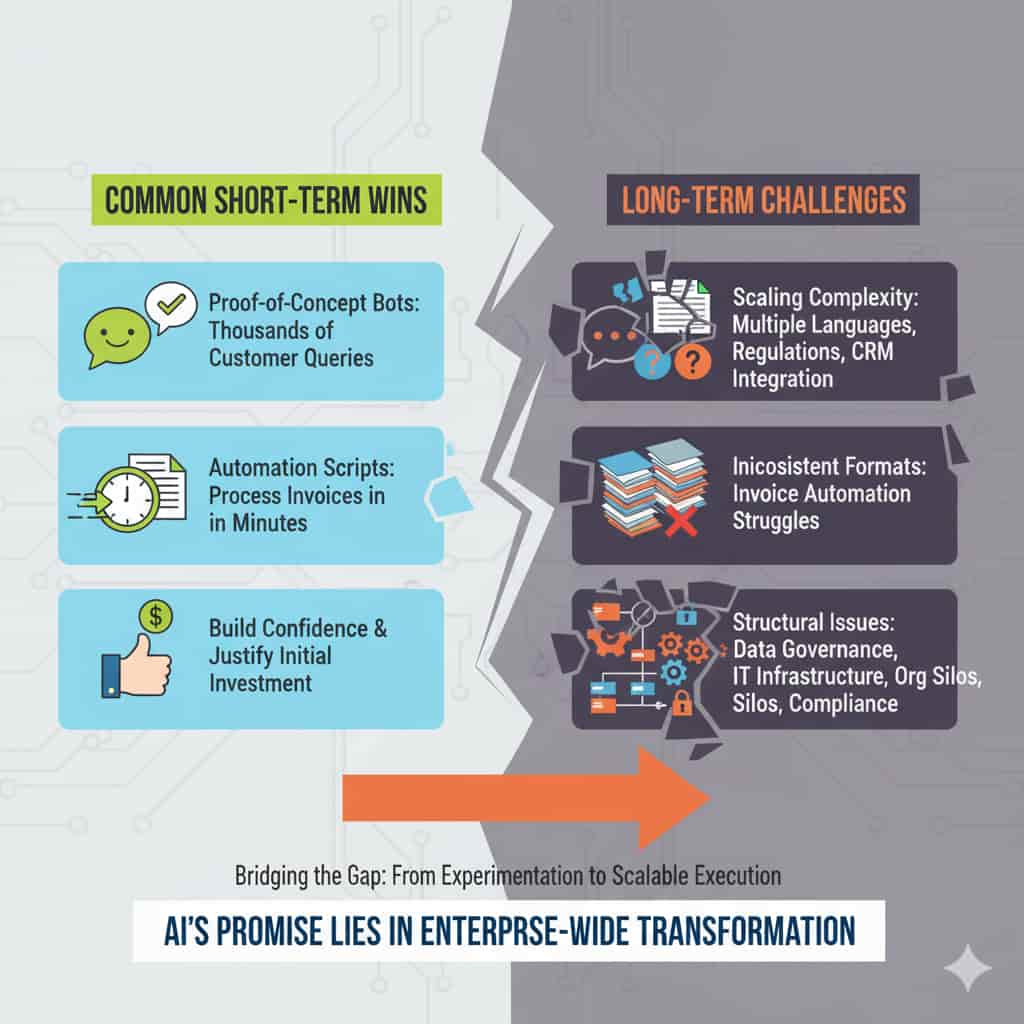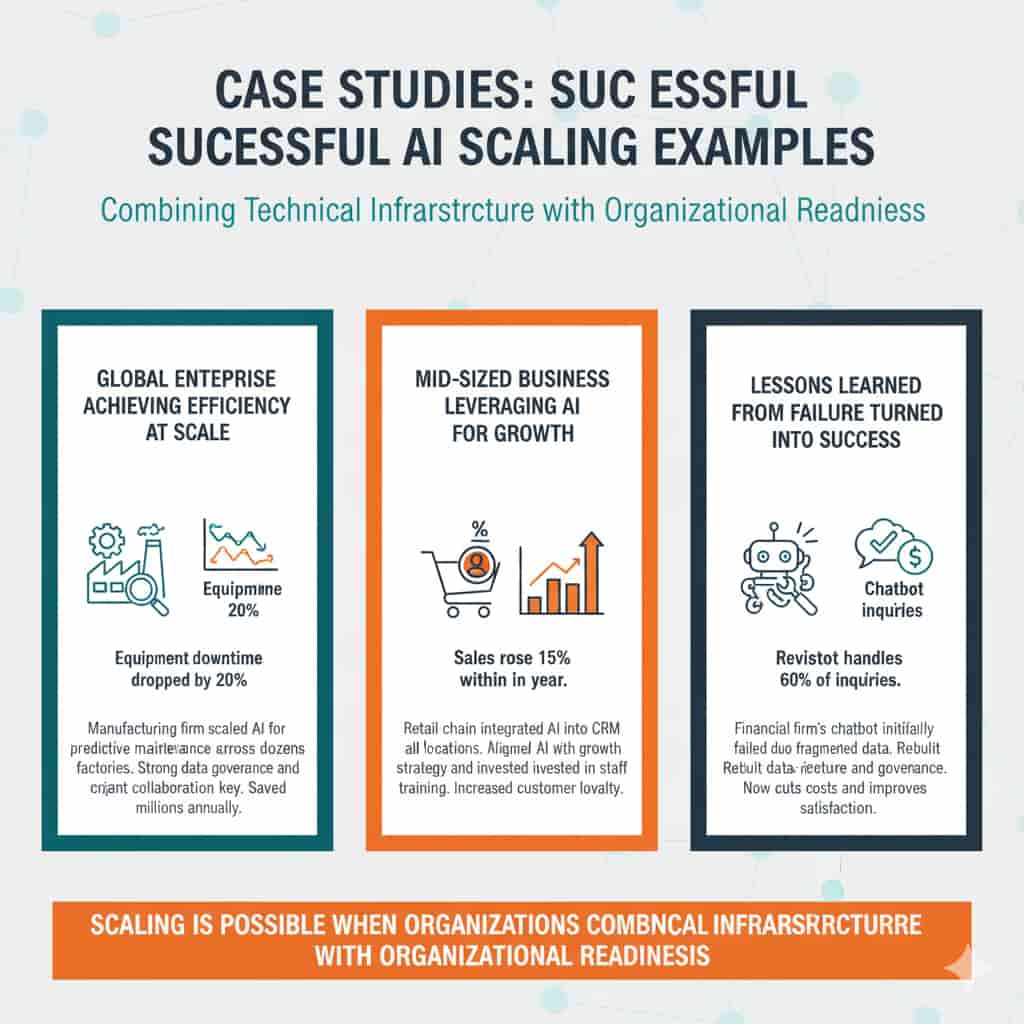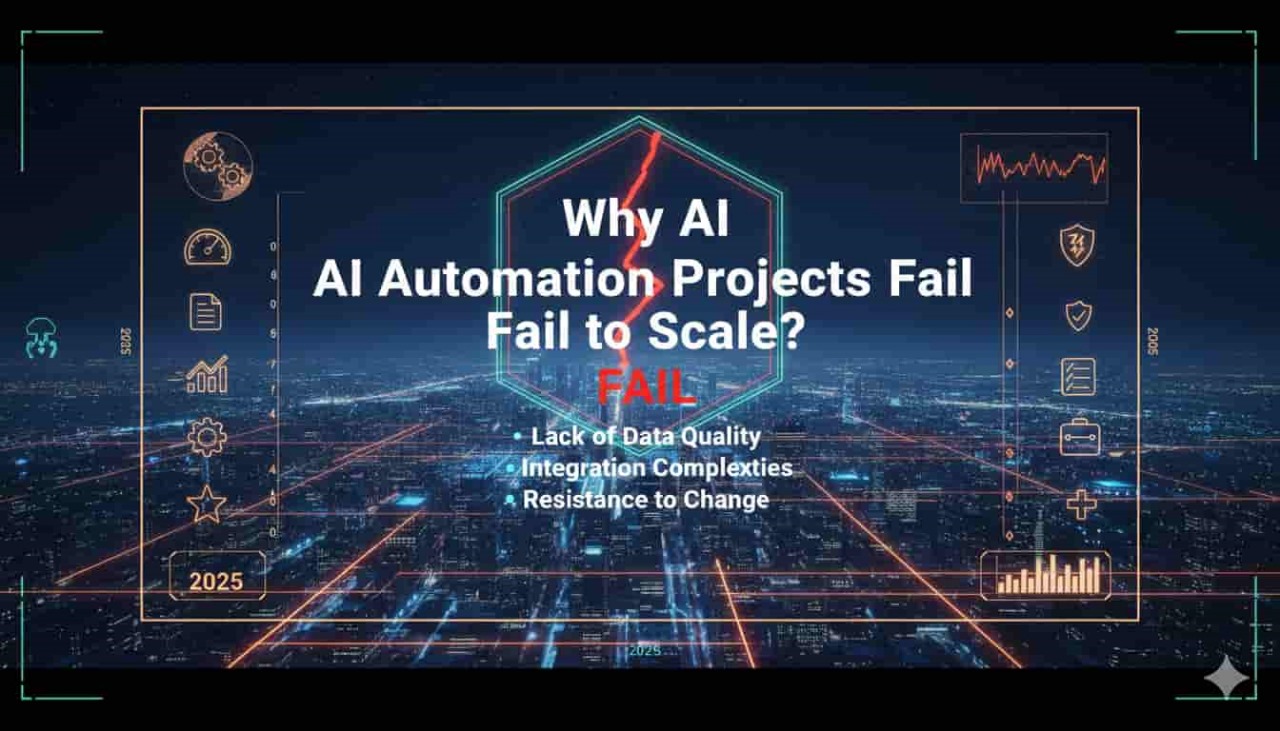Introduction
AI Automation has a lot of potential, many businesses find it difficult to move from pilots to enterprise wide implementation. Early successes may seem promising, but scaling frequently reveals hidden difficulties. Building sustainable, long term business value and preventing investment waste require an understanding of the reasons behind AI automation projects’ failure to scale.
What Does It Mean to Scale AI Automation?
Scaling AI Automation involves more than just implementing a few isolated use cases or successful pilots. The goal is to spread those successes throughout several departments, procedures, and business divisions while preserving effectiveness, dependability, and compliance.
Consider it similar to planting a garden. While it’s nice to have one flower bloom, scaling entails growing a whole flourishing field. Every plant needs the same amount of soil, water, and attention. Scaling AI Automation in business requires robust data pipelines, governance frameworks, core system integration, and strategy alignment.
Businesses frequently test AI Automation in a controlled setting during the pilot stage, such as when creating a chatbot or automating the processing of invoices. Technical viability is typically demonstrated by these projects. However, companies encounter obstacles such as dispersed data sources, outdated IT systems, irregular workflows, and cultural resistance when they try to duplicate success across hundreds of processes.
Preparing for future expansion is another aspect of scaling AI Automation. An enterprise-wide implementation of a single department solution may result in failure. Costs skyrocket, risks increase, and benefits decrease in the absence of meticulous planning.
In the end, scaling AI involves more than just technology; it involves integrating AI into the very core of the company. Strong governance, clear business alignment, cross functional cooperation, and leadership buy in are necessary for that. Successful businesses view scaling as a process rather than a technical advancement.
The Promise vs. Reality of AI at Scale
3.1 The business expectations driving AI investment
The excitement around AI Automation is fueled by bold promises: cutting costs, improving efficiency, and creating new value streams. Business leaders expect AI to reduce manual work, optimize decisions, and open doors to competitive advantages. Analysts and vendors often project double digit returns, convincing companies to invest heavily.
The vision is compelling. Imagine faster customer service powered by chatbots, streamlined supply chains through predictive analytics, or finance teams freed from routine reporting. Leaders envision AI transforming the organization’s operating model, positioning it for the future.
3.2 Common short-term wins vs. long-term challenges
AI Automation frequently performs well in the early phases. Thousands of consumer inquiries are answered by a proof of concept bot. Invoices are processed in minutes rather than hours by an automation script. These quick victories boost self esteem and make the initial investment worthwhile.
However, scaling is where promise and reality diverge. The complexity of growing from a single chatbot to a fully digital workforce includes integrating with core CRM systems, managing multiple languages, and taking regulations into account. Invoice automation functions well in one area but has trouble with different formats in another.
It is frequently too late for leaders to realize that scaling calls for much more than just reproducing a successful pilot. Data governance, IT infrastructure, organizational silos, compliance frameworks, and workforce readiness are structural issues that must be addressed. Projects stall, expenses increase, and enthusiasm wanes in the absence of these foundations.
In other words, enterprise wide transformation, rather than discrete victories, is where AI Automation promise lies. Moving from experimentation to methodical, scalable execution is necessary to close that gap.

Top Reasons AI Automation Projects Fail to Scale
4.1 Lack of clear business alignment
One of the most common pitfalls is propulsion AI Automation projects without linking them to business goals. Pilots often novelty rather than impact. Without alignment, order becomes difficult to justify. Leaders should ask: Does this AI Automation initiative solve a real business problem?
4.2 Poor data quality and fragmentation
AI Automation thrives on data. But in many form, data is siloed, inconsistent, or incomplete. Pilots often use clean test data, but scaling exposes messy world duplicate records, missing fields, conflicting formats. Without robust data government, AI Automation outputs lose reliability.
4.3 Overreliance on pilot projects without a roadmap
Many institution get stuck in “pilot purgatory.” They test repeatedly without a clear path to production. Scaling requires a roadmap that outlines integration steps, quantifiability requirements, and long term support.
Other, pilots remain isolated experiments.
4.4 Insufficient governance and compliance frameworks
As AI Automation spreads across the enterprise, risks multiply bias, privacy violations, regulatory non-compliance. Without governance frameworks, organizations risk reputational damage and legal penalties. Body ensures transparency, answerableness, and ethical AI Automation use.
4.5 Organizational silos blocking collaboration
AI scaling demands collaboration across IT, operations, conformation, HR, and business units. Silos slow down integration and create conflicting priorities. Breaking down barriers requires strong leadership and cross functional teams aligned to shared goals.
4.6 Underestimating infrastructure and integration costs
Pilots often run on small scale setups. Scaling requires robust infrastructure: cloud resources, desegregation with ERP and CRM systems, observation tools, and cybersecurity layers. Many underestimate these costs, leading to stalled rollouts.
4.7 Change management resistance across teams
Employees frequently fear AI will replace jobs or disrupt routines. Resistance can derail adoption. Without clear communication, reskilling programs, and employee involvement, scaling faces cultural roadblocks.
4.8 Skills gap in AI and automation talent
Scaling AI requires specialized talent data engineers, ML experts, automation architects, governance specialists. Many organize lack these skills internally and face aggravated competition for talent externally. Without investment in training and recruitment, scaling stalls.
4.9 Vendor lock-in and inflexible technology choices
Choosing a vendor-specific platform may limit flexibility. As needs evolve, organizations struggle to accommodate or switch providers. Vendor lock in creates dependencies, cost inflation, and integration challenges. Open, interoperable platforms reduce these risks.
4.10 Unrealistic ROI timelines and measurement gaps
Finally, many projects fail because leaders expect quick returns. But scaling takes time. Benefits may not appear for 12–24 months. Without down to earth timelines and robust ROI measurement, stakeholders lose patience and funding dries up.
The Business Impact of Failed Scaling
5.1 Financial consequences and wasted investment funds
Failed scaling wastes zillion spent on pilots, software, and infrastructure. Make end up with sunk costs and little measurable value. The possibility cost is even higher resources could have funded other strategic initiatives.
5.2 Loss of competitive advantage
Competitors that successfully scale AI gain ratio and innovation advantages. Organise stuck in pilot mode risk falling behind, missing market opportunities, and losing connection.
5.3 Erosion of stakeholder trust and support
Repeated failures erode trust among governance, worker, and investors. Enthusiasm turns into skepticism. This makes it harder to secure future funding, slowing digital modification momentum.
The accumulative impact can be significant: wasted capital, lost growth opportunities, and declining confidence in technology driven strategies.
How to Build Scalable AI Automation Successfully
6.1 Align AI initiatives with business strategy
Every AI initiative should tie directly to business concern goals reducing costs, improving customer experience, or creating new revenue. Clear alliance makes scaling justifiable and measurable.
6.2 Establish robust data governance practices
Scaling requires trustworthy data. Companies should invest in data quality programs, master data direction, and incorporated data platforms. Governance ensures consistency, security, and compliance.
6.3 Build enterprise-wide infrastructure for scalability
Scalable AGENCY requires flexible cloud substructure, APIs for integration, monitoring systems, and security frameworks. Investing primal prevents costly retrofitting later.
6.4 Foster cross-functional collaboration
Create multidisciplinary teams combining business leaders, IT, compliance, and operations. Collaboration ensures AI serves shared objectives and avoids siloed deployment.
6.5 Invest in workforce training and reskilling
AI doesn’t replace people it augments them. Training programs help employees adapt, reducing resistance. Upskilling ensures organizations have the talent to maintain and expand AI.
6.6 Adopt flexible, interoperable technology platforms
Choose platforms that support integration, customization, and multi vendor ecosystems. Flexibility reduces vendor lock in and future-proofs the investment.
6.7 Define realistic KPIs and ROI models
Set clear metrics for success: Decreased cycle times, error reduction, customer satisfaction. Establish realistic timelines to manage expectations and maintain support.
6.8 Implement agile governance and risk management
Organization shouldn’t stifle innovation. Adopt agile theory that balance compliance with flexibility. Regular audits, ethical reviews, and clear answerability help manage risks.
6.9 Start with scalable use cases, not isolated pilots
Choose use cases that are applicable to the entire organization. Develop a customer service automation framework that is cross regional and cross-lingual rather than testing a man-to-man chatbot.
Scaling is not a race; it’s a marathon. Business organizations can go beyond pilots and achieve genuine impact by integrating organizational alignment, cultural transformation, and technical readiness.
Case Studies: Successful AI Scaling Examples
7.1 Global enterprise achieving efficiency at scale
A global manufacturing firm piloted AI for predictive maintenance. After success in one plant, they built a centralized data horizontal surface and scaled it across dozens of factories. Equipment downtime dropped by 20%, deliverance millions annually. The key: strong data governance and cross-plant collaboration.
7.2 Mid-sized business leveraging AI for growth
A mid-sized retail chemical chain used AI for individualized marketing. Instead of limiting it to one region, they integrated AI into their CRM across all locations. Sales rose 15% within a year. Their success came from aligning AI with growth strategy and investing in staff training.
7.3 Lessons learned from failure turned into success
A financial services firm ab initio failed to scale its chatbot due to fragmented data and compliance issues. After revisiting governance frameworks and rebuilding their data architecture, they relaunched successfully. The chatbot now handles 60% of routine inquiries, cutting costs and improving satisfaction.
These examples show scaling is possible when organizations combine method infrastructure with organizational readiness.

Future Trends in Scalable AI Automation
8.1 Rise of AI as a service models
Cloud providers are making AI accessible through subscription services. This bunk entry barriers and change rapid scaling without massive upfront investment.
8.2 Increasing focus on ethical AI and compliance
As AI spreads, regulators demand transparency and fairness. Organizations will need governance frameworks that ensure compliance while building stakeholder trust.
Read more: Why 95% of AI Projects FAIL and How to FIX Them (MIT Study)
8.3 Democratization of AI through low-code/no-code tools
Low code platforms empower non technical staff to build and scale AI-driven workflows. This demo accelerates adoption, reduces reliance on insufficient talent, and fosters innovation.
Future scalability will hinge not just on technology but also on how organizations embrace these trends responsibly.
Read more: Why Do 95% of AI Projects Fail So Badly?
Conclusion
While difficult, scaling AI automation is not impossible. The foundations of data governance, infrastructure, collaboration, and change management are frequently neglected, which contribute to the gap between pilot successes and enterprise-wide transformation.
Businesses that ignore these issues run the risk of losing out on opportunities and squandering money. However, long-term business value can be unlocked by those who invest in scalable infrastructure, align AI initiatives with strategy, and cultivate an adoption culture.
Patience, preparation, and perseverance are necessary for the journey. Building long-lasting systems that expand with the company is the goal of scaling, not racing from one pilot to the next. Businesses can go beyond isolated experiments and fully utilize AI at scale by embracing best practices and learning from common pitfalls.
Read more: How Safe Are AI-Powered Airplanes? Best Insights 2025
Frequently Asked Questions (FAQs)
10.1 What is the difference between AI pilots and scaling AI?
Pilots test feasibility in controlled environments, often focusing on narrow use cases. Scaling involves integrating AI across multiple systems, teams, and regions with consistent reliability, governance, and impact.
10.2 How long does it typically take to scale AI automation?
Timelines vary, but most organizations need 12–24 months to move from pilots to meaningful scale. Complexity, data readiness, and organizational alignment significantly influence speed.
10.3 What role does data governance play in AI scalability?
Data governance ensures data quality, consistency, security, and compliance. Without it, AI outputs lose reliability, making scaling risky and ineffective.
10.4 How can companies calculate ROI for AI automation?
ROI should measure both financial and non-financial impacts. Metrics can include cost savings, cycle-time reductions, accuracy improvements, customer satisfaction, and revenue growth. Long-term value often outweighs short-term gains.
10.5 What are the biggest risks of vendor lock-in?
Vendor lock-in reduces flexibility, inflates costs, and makes switching providers difficult. Organizations should prioritize open, interoperable platforms to maintain control and adaptability.
10.6 Do small and mid-sized businesses face the same scaling issues as enterprises?
Yes, but at a different scale. Smaller businesses may face tighter budgets and fewer technical resources, but they benefit from agility and less legacy system complexity.
10.7 How can leadership drive cultural change for AI adoption?
Leaders must communicate the purpose of AI, highlight its benefits, and support workforce training. Involving employees in design and rollout builds trust and reduces resistance.
10.8 What industries are leading in scalable AI automation?
Manufacturing, financial services, healthcare, and retail are among the leaders. They use AI to optimize supply chains, improve customer service, enhance diagnostics, and personalize experiences.
10.9 How will generative AI impact scalability challenges?
Generative AI will expand possibilities—automating content creation, code generation, and customer engagement. But it also introduces new risks around governance, intellectual property, and compliance that must be addressed before scaling.


1 thought on “Why AI Automation Projects Fail to Scale 2025”